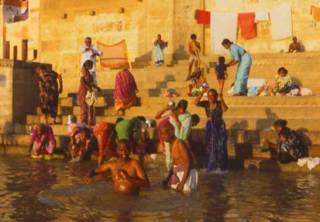As the sun begins to rise, throwing golden shafts of light on Varanasi's sandstone buildings, the city becomes a kaleidoscope of purples and pinks, ochres and oranges. The city's other ghats start to hum with activity. Bathers, many fully-dressed, immerse themselves in the fetid water, palms together in prayer. Men, women and children wash clothes in the river and spread them to dry along the steps of the bathing ghats. Saddhus dispensing blessings and wisdom sit under umbrellas, waiting for customers. Contortionists in linen loincloths face into the rising sun, exercising, stretching, preening. Child peddlers paddle boats filled with votive candles in lotus blossom leaves. They approach you with hands outstretched. You buy a candle and send your offering floating down the Ganges.
Our boatman rows us back to shore. We pass another boat. It holds a family making its slow, sad way to the middle of the river. The father holds a tiny body wrapped in white. An infant, to be received by Mother Ganga.

